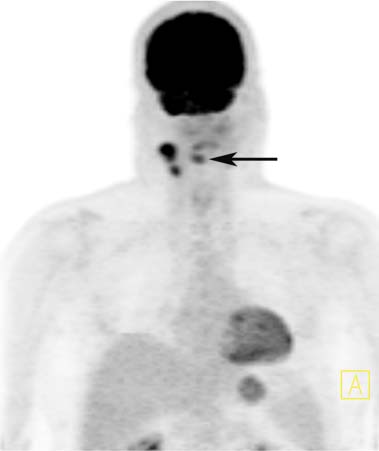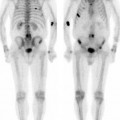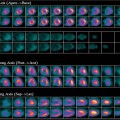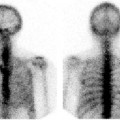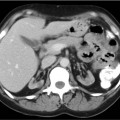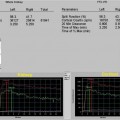CASE 84 A 53-year-old man has a diagnosis of squamous cell carcinoma of the base of tongue with neck nodal metastases. PET is requested for the purpose of planning radiation therapy. Fig. 84.1 Fig. 84.2 • The patient is instructed to avoid vigorous exercise for 24 hours prior to the scan, fast for at least 4 hours before the study, drink water during the fasting and uptake periods, and void prior to the scan • A venous serum glucose sample is obtained prior to the injection of 18F-FDG (reference range is < 120 mg/dl for non-diabetic patients and < 200 mg/dl for diabetic patients), and the patient’s height and weight are recorded • A 10–20 mCi dose of 18F-FDG is injected intravenously (in a dimly lit quiet room for brain PET scans), and the patient is asked to rest comfortably in a room that is kept warm • Sixty minutes following the 18F-FDG injection, the spiral CT is performed using a weight-based algorithm from the skull base to the upper thighs (for most oncologic indications), or from the vertex to the feet, or centered over the brain depending on the tumor being evaluated • A 2D or 3D PET acquisition (depending on the manufacturer) is then performed over the same region (s), and all PET images are corrected for attenuation, detector efficiency, scatter, decay, and random coincidences • Consistency in 18F-FDG injected dose, scan acquisition time relative to the injection time, and acquisition and reconstruction protocols is important when performing serial scanning on the same patient An anterior maximum-intensity pixel (MIP) image (Fig. 84.1) demonstrates uptake within the primary tumor just to the right of midline (arrow) and within two right-sided lymph nodes. Axial images (Fig. 84.2) reveal uptake in the primary lesion at the base of the tongue (arrows) and in one of the lymph nodes (arrowheads). The other involved node is at a different axial level.
Clinical Presentation
Technique
Image Interpretation
Differential Diagnosis
Stay updated, free articles. Join our Telegram channel

Full access? Get Clinical Tree


